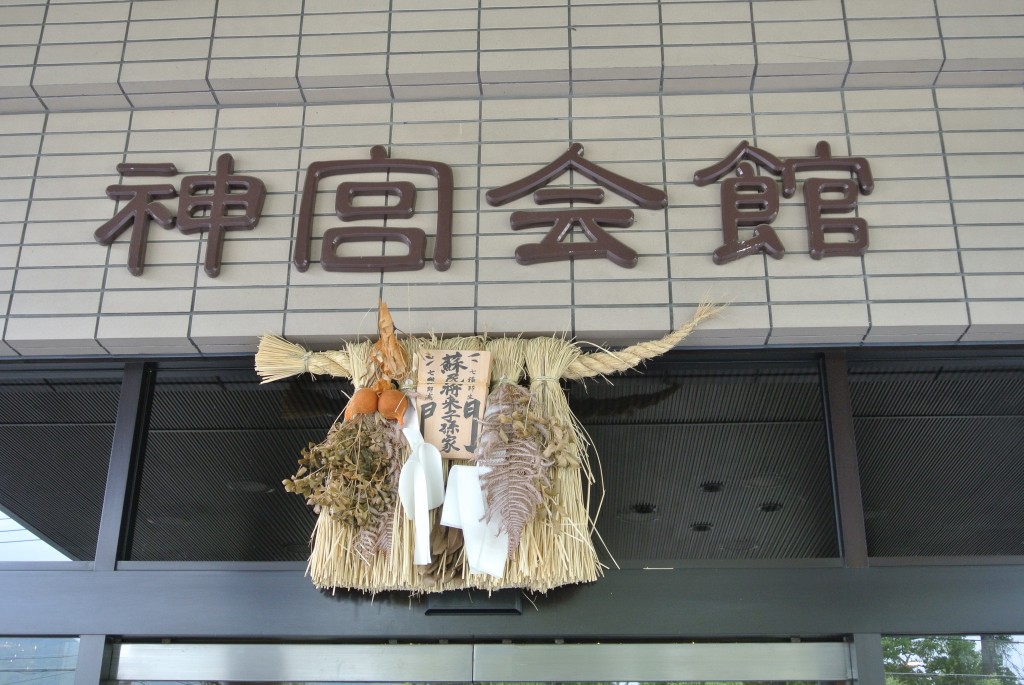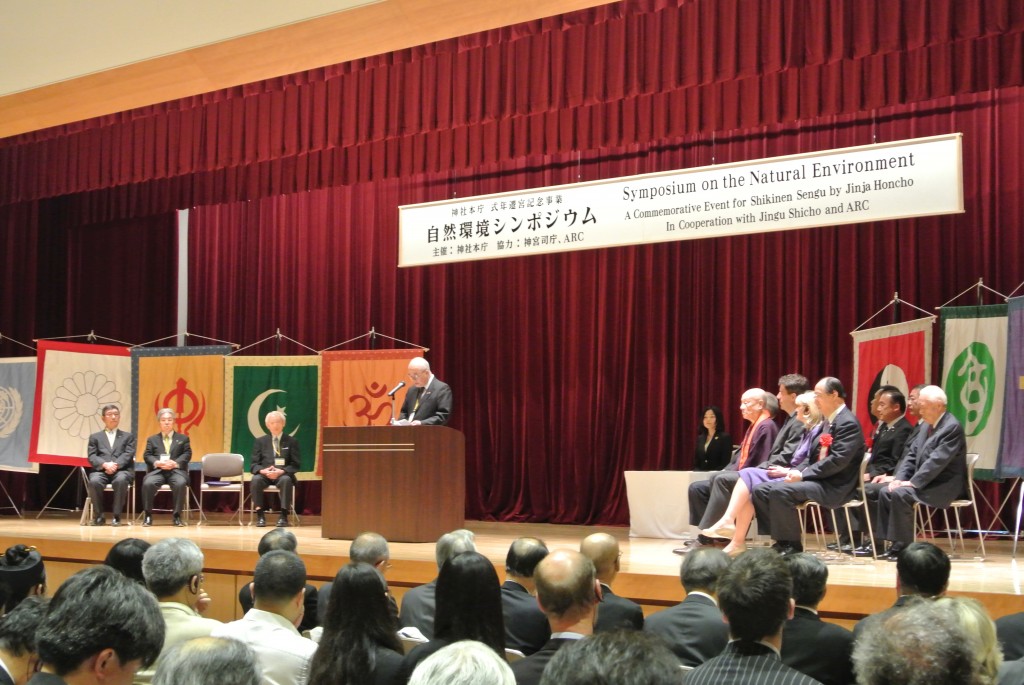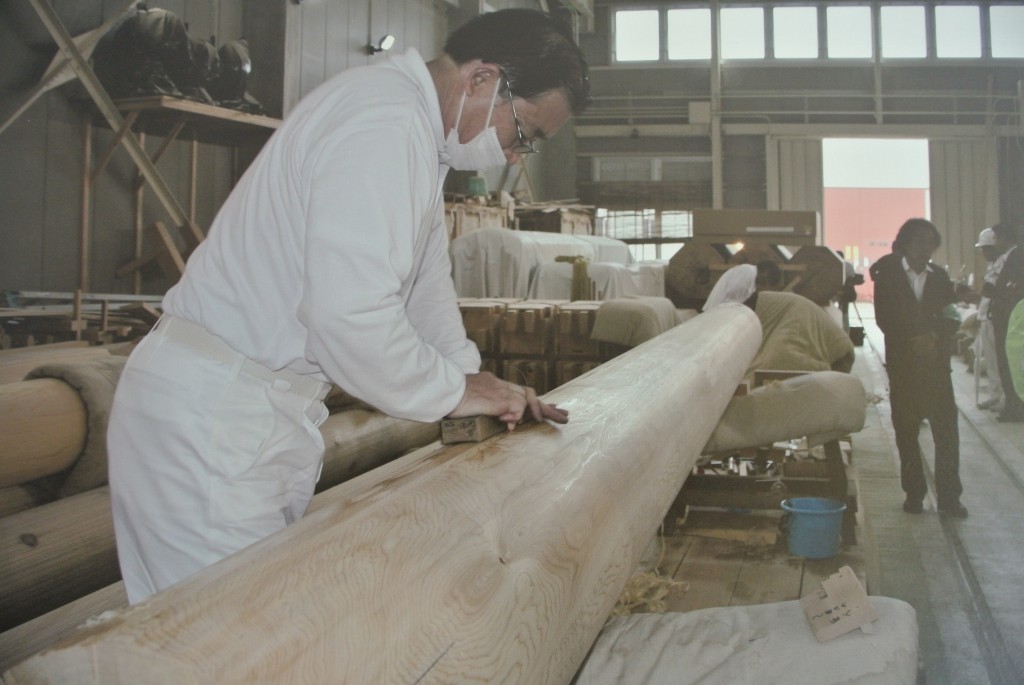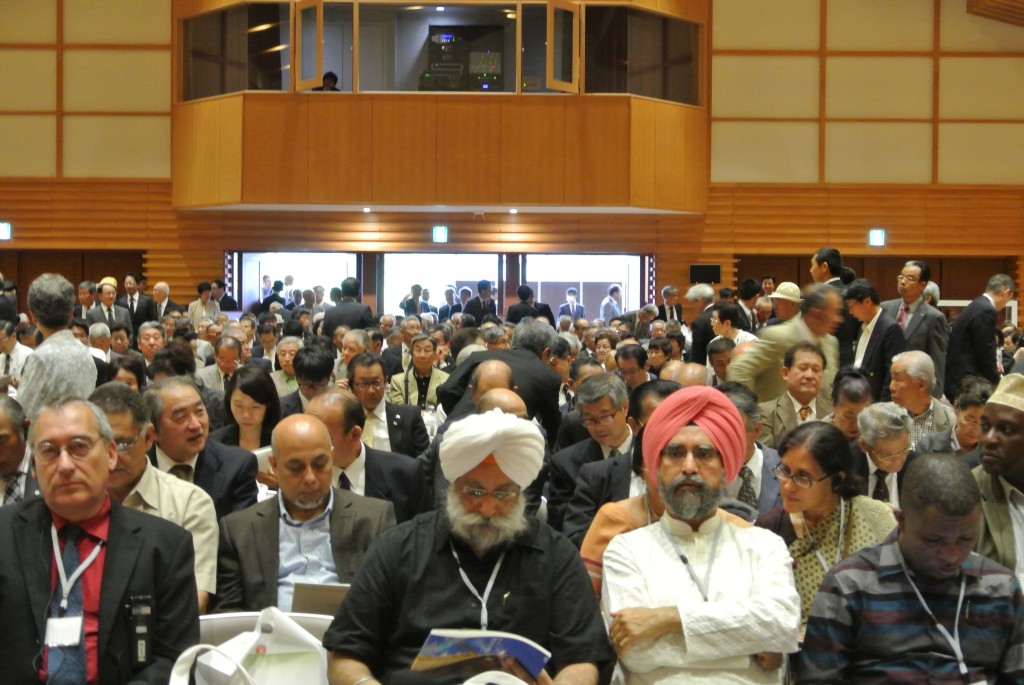
The entrance to Jingu Kaikan at Ise with a New Year decoration left up in June. In the Mie area it's a traditional custom to leave the decorations up all year to bring good fortune.
This is the second part of a report on the international gathering concerning Shinto and the environment jointly sponsored by Jinja Honcho and ARC (Alliance of Religions and Conservation). For Part One, see here.
*******************************************
One of the conference days was set aside for a Symposium on the National Environment, when the 60 international members meeting under ARC’s auspices were joined by some 700 Shinto priests in the Jingu Kaikan at Ise. It formed part of the commemorative events for the 62nd renewal of Ise Jingu and was dedicated to exploring the co-existence of human beings with nature.

Dignitaries including the Deputy Secretary General of the UN, the British Ambassador, the Deputy Minister of the Environment, the Governor of Mie, the deputy mayor of Ise as well as the heads of Jinja Honcho and Ise Shrine. At the back of the stage can be seen Princess Akiko.
Introductory messages from the likes of the British Ambassador, the Governor of Mie Prefecture, and the Deputy Secretary General of the United Nations were followed by two special guest lectures by Princess Akiko (of the Mikasa imperial house) and the patriarch of Koyasan Shingon Buddhism, Yusei Matsunaga, 412th to hold the post.
In addition, there was a panel discussion coordinated by the president of Jinja Honcho featuring the Senior Priest of Ise and Dr Robert Cambell, a bilingual professor of Japanese literature in the graduate school of Tokyo University. Here then was a most unusual event, featuring amongst others a Buddhist and a foreigner lecturing Shinto priests in their very own spiritual home.
As might be expected on such occasions, politeness was universal and controversy avoided. Nonetheless there were glimpses of an underlying tension between particularism and universalism. The president of Jinja Honcho for instance spoke of winning understanding for the special Japanese way of seeing things, whereas the Governor of Mie Prefecture quoted Arnold Toynbee’s remark about ‘the underlying unity of all religions’.
Ise rebuilding
For his part the head priest of Ise gave a statistical overview of the process of logging involved in the 20 year renewal cycle of the shrine. This had been carried out for 1300 years, with interruptions during the Warring States Period (Sengoku Jidai) and also a delay after WW2. It involved the felling of 10.000 hinoki (cypress) trees, each of which had to be over 50 cm in circumference at the height of the human chest.
During the Edo Period, when conservation was not an issue, the mountains had been laid bare because of the provision for pilgrims, particularly charcoal and firewood. Extensive replanting had taken place in the twentieth century, though for hinoki to mature it takes some 200 years. The shrine is committed to growing its own trees for future rebuilding, but for sustainability to be maintained it is estimated that 100 hectares is necessary. Moreover, the forest has to be well-tended, which requires cutting, planting, providing access, and the thinning of sickly and weak trees. It adds up to a substantial cost of some 200 million yen a year.

Preparing a hinoki log for the rebuilding of Ise Shrine
For his part the patriarch of Shingon Buddhism pointed out that it shared much with Shinto in seeing connections with nature as fundamental. In Buddhism all living things have Buddha nature, but the spirituality of inanimate things was an idea from Shinto, as seen in rituals for broken needles, old dolls, etc. When the Dalai Lama came to Japan, he was apparently asked about the soul of inanimate objects and responded, ‘That’s Shinto, isn’t it?’ It was a worldview which separated it from Buddhism, but one that was important to nurture in the present world.
Princess perspective
The talk by Princess Akiko was the most entertaining and personal of the afternoon. It raised the question of whether Shinto was a matter of belief or simply part of the Japanese way of life. With a doctorate in Japanese art history from Oxford University, she spoke of her impressions of living abroad. Japan was said to be proud of having four seasons, she noted, but Britain often had four seasons in one day. Moreover, whereas British water was good for black tea, Japanese water was good for green tea.
But what made the most impression on her was the British supermarkets had the same food throughout the year, which made her miss the seasonal nature of Japanese food. There was something in Japanese culture that was in tune with the changing seasons of nature. It had to do with an affinity for the deities living in rocks, waterfalls and trees, etc. It was, she suggested, difficult for foreigners to appreciate.
It was the pluralism of Japanese thinking that led to another aspect difficult for foreigners to comprehend. ‘Born Shinto, marry Christian, die Buddhist’ was an accepted path in Japan. Because of polytheism, it was easy for Japanese to accept any kind of deity as valid. She herself had felt power and refreshment from a rock at Suwa Shrine named after Susanoo no mikoto. And as a child, she had felt a sense of awe at the woods of Ise Jingu.
So what in the end was Shinto? ‘Pay respects and have gratitude to the kami,’ she had been told by a priest. It’s not a question of salvation or belief as in Abrahamic religions, but of simple things like saying itadakimasu before meals and gochisosama afterwards. For Japanese these aspects of daily life enrich their existence.

A full house at Jingu Kaikan, with ARC representatives at the front behind whom are some 700 priests, mostly dressed in suits.

Hi John, Have any publications come out of this landmark conference yet? I’d be particularly interested in anything in English. Or is it too early? I know how long it can take to get such things organised. Thanks very much.
Hallo… I haven’t heard news of any proceedings, and I’d be surprised if there were any actually as it wasn’t that kind of a conference. The significance was more in establishing an interfaith meeting of minds, rather than any academic-style papers…
Thanks John, I thought that some transcripts, or possibly summaries of what was discussed/concluded, might be made available for those who weren’t at the conference. I can understand that the significance of the event itself could be considered enough.
Akiko-Joō, definitively a proof that the combo Monarchy + Shintoism give birth to good taste.
But I wonder… maybe that’s why the Amatsukami colonized the Kunitsukami… ? They wanted seasonal food rather than eating sunlight and space radiations ! Asteroïd icy water surely has a poor taste with both black and green tea… :P